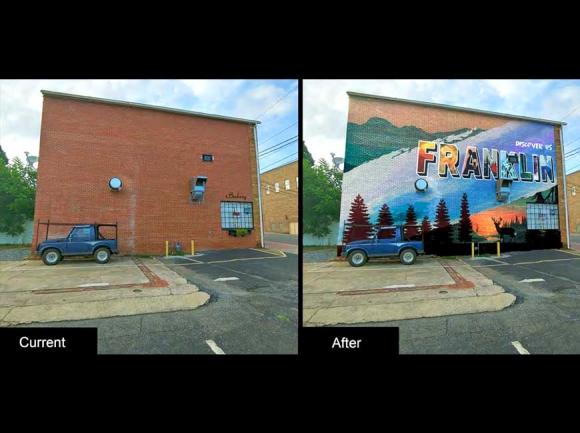Franklin unveils land use plan
 Adding public art in Franklin is just one of many ideas presented during public comment into the town’s Comprehensive Land Use Plan. Donated photo
Adding public art in Franklin is just one of many ideas presented during public comment into the town’s Comprehensive Land Use Plan. Donated photo
The town of Franklin is working toward creating a vision for the community that will guide growth and investment for years to come.
For more than a year, a 10-member community steering committee has been working toward drafting the town’s first Comprehensive Land Use Plan. The draft was unveiled to the community March 4 during a presentation that also included plenty of feedback from community members.
Even though it’s the town’s first comprehensive land use plan, Town Planner Justin Setser said the plan builds on prior efforts, including the town’s Principles of Growth outlined in the Unified Development Ordinance as well as the Downtown Franklin Master Plan from 2008 and BikeWalk Franklin completed in 2017.
The plan isn’t just about future land usage and zoning though — it also encompasses ideas to improve downtown and other areas of Franklin, economic development, infrastructure and transportation needs and how to better incorporate the town’s many natural and cultural resources.
After five steering committee meetings, eight community meetings and 420 survey responses, Steven Baker with Stewart Consulting said it was fairly clear the things residents and businesses love about Franklin. People love the small-town character, they love the natural beauty and access to nature, the sense of community and hospitality, low traffic and festival and events.
“With Franklin, it’s all about town character — the mountains and access to nature and the people — the people coming into the community and the people who’ve been here,” he said.
Related Items
When asked what they would like to see improve in Franklin, survey respondents said they wanted to have better internet service, availability of good jobs, improved community aesthetics, more retailers and restaurants, stronger downtown, more sidewalks, bike lanes and greenways, solutions to the drug problem, attractions for families, connections to the river and medical services.
The town of Franklin encompasses a wide variety of land uses from downtown to wooded hillsides, rural homesteads to multi-family dwellings and industrial and commercial centers. The comprehensive plan process examined the development patterns in the community that will shape growth in the future and how the town can better facilitate that growth in a purposeful way.
When looking at the future of residential development, 59 percent of those surveyed said they wanted to see homes with smaller yards within walking distance to downtown, shared open spaces and parks, while 51 percent said they’d like to see more low-maintenance homes or townhouses.
While respondents named affordable and workforce housing as a top need in Franklin, the majority said they’d prefer to see more small single-family homes as opposed to high-density townhomes or multi-level apartment buildings.
As for commercial development, Baker said people in the community enjoyed the feel of downtown Franklin with active storefronts, pedestrian walkways and on-street parking.
“They don’t like the shopping center looks. Even though Franklin has some of those too, it’s not something y’all want to see more of,” he said.
Residents are proud of their downtown, but they also see opportunities for improvements. They want to see all storefronts filled, outdoor dining, the upper levels of the buildings renovated and used for apartments or office space, more public art and facade standards to give downtown a cohesive look.
“Currently, there are many challenges and opportunities for Franklin’s downtown. While many of the ground floors are in use along Main Street, the buildings’ upper stories are vacant providing both challenges in upfitting due to their repair costs but also serve as unused supply for potential apartment, condo, or office uses,” the draft plan reads.
Setzer said he’s gone to look at some of the upper level properties on Main Street to see what might be possible in the future, but ultimately it comes down to the private owners to push for more usage.
“Downtown is in an ‘Opportunity Zone’ so there’s a lot of potential for an investor in those areas to get some tax credits, especially if it’s creating jobs for residents,” he said. “But it’s going to take coordination from property owners as well.”
Baker said people acknowledged that there are other areas of town that need improvements.
“Main Street isn’t the only important street — there are also important side streets and alleys that need to get some attention,” he said.
Restriping parking on Palmer Street and adding mini pocket parks or streetscaping would help improve these secondary streets and draw more foot traffic to those backstreet businesses downtown.
Before making recommendations, the steering committee, with the help of Stewart Consulting, had to assess what the town has to work with — population demographics, how much land is vacant, what can be built on it, environmental restraints, existing industries and job opportunities.
Franklin residents also identified many transportation needs — but more so regarding sidewalks, bike lanes, trails and river accesses than roadways. Franklin’s pedestrian and bike plan includes many ideas for connecting sidewalks, greenways and creating new trails and bike lanes. The town is slowly filling in sidewalk projects but some of the more complicated projects are still awaiting funding.
“A well-developed bicycle and pedestrian network provides a way for people of all ages and abilities to travel in a way that is safe, comfortable, accessible and active. It connects people to community destinations, improves bicycle and pedestrian safety, multimodal opportunities, encourages active living, and provides a community amenity,” the plan states.
The goals laid out in the draft plan include creating walkable, mixed-use districts and neighborhoods in Franklin with a “distinct sense of place. Baker said this type of growth will reinforce Franklin’s identity as a small mountain town while improving quality of life for residents and business owners.
This is where new land use and zoning regulations can be developed, Baker said. By reducing lot sizes and open space requirements between parcels, the town could encourage smaller houses or multi-family units within walking distance of downtown or other neighborhoods.
“There are people wanting to downsize and there are younger generations coming in that are not wanting a bigger home,” Baker said.
Something the town could do immediately is improve its gateway corridors by setting facade requirements and add landscaping.
The plan also identifies new districts that can be regulated and developed for the future, including Nikwasi Cultural Arts District and River Market/Whitmire District. Since the town turned over ownership of Nikwasi Mound to nonprofit Nikwasi Initiative, the Eastern Band of Cherokee Indians has a major interest in developing property around the mound to educate people about Cherokee culture and history.
The town still owns about 13 acres right in town known as the Whitmire property — a large green space that has plenty of potential. The town paid to have a study done to see the best usage of the property but still hasn’t moved forward with any plans.
“There could be a cultural element there or an opportunity to bridge the gap between the river and residential mixed-use,” Baker said.
Stacy Guffey with Stacy Guffey & Associates briefly discussed the economic development and infrastructure piece of the plan.
“There’s a couple things we wanted to do — one is to assess where we are currently, looking at strategies that are working in other communities and being realistic of what we can do in Franklin,” he said.
While Macon County would love to see more manufacturing jobs move in, Guffey said the hard reality is that Franklin has to compete with places all over the country when it comes to manufacturing jobs. But another truth is that people move to Franklin because of the quality of life it offers compared to larger towns and urban cities. Protecting that quality of life will ultimately drive the economy.
Improving broadband is a crucial component of fostering entrepreneurship and small businesses in Franklin. Guffey said expansion of broadband is already in the works, but he’d also like to see a survey to assess the needs of tech businesses and the growth of heritage tourism and outdoor recreation.
“It all ties into quality of life — that’s the economic driver. Y’all moved here from other areas because of all that and the same is true of business owners,” Guffey said.
There’s so much more included in the draft plan, which can be viewed at www.franklintownplan.com. Setser said the steering committee would be presenting the plan to the town planning board at 4 p.m. March 16 at town hall and if the board approves it, the draft will move on to a public hearing before the town council at its April 6 meeting. The town could adopt the plan as early as May.
See the complete presentation of the plan during the March 4 meeting at www.maconmedia.com.









